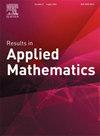多元空间条件u分位数:一种Bahadur-Kiefer表示
IF 1.3
Q2 MATHEMATICS, APPLIED
引用次数: 0
摘要
分位数是概率论和理论统计学中的一个核心概念,在广泛的应用中是不可或缺的工具。尽管分位数的单变量概念在直观上是清晰的,并且在数学上得到了很好的建立,但将这一概念扩展到多变量框架会带来重大的理论和实践挑战。将单变量分位数扩展到多变量设置的一种行之有效的方法是空间(或几何)框架,其经验对应物表现出显著的鲁棒性,并承认一个优雅的bahadurr - kiefer表示。独立地,单变量分位数的另一种推广导致u分位数,它自然包含经典估计量,如集中趋势的Hodges-Lehmann估计量。在本研究中,我们通过引入多变量条件空间u分位数并推导其相应的bahadurr - kiefer表示来弥合这些观点。这种表示使我们能够建立基本的理论性质,包括弱收敛性和迭代对数定律。这些结果在Vapnik-Chervonenkis类函数的一些标准结构条件和模型的一些温和条件下得到了证明。本文讨论的一致极限定理是进一步发展涉及经验过程技术的数据分析的关键工具。本文章由计算机程序翻译,如有差异,请以英文原文为准。
Multivariate spatial conditional U-quantiles: a Bahadur–Kiefer representation
Quantiles constitute a core concept in probability theory and theoretical statistics, providing an indispensable instrument in a wide array of applications. Although the univariate notion of quantiles is intuitively clear and mathematically well established, extending this concept to a multivariate framework poses significant theoretical and practical challenges. A well-established approach to extending univariate quantiles to the multivariate setting is the spatial (or geometric) framework, whose empirical counterparts exhibit notable robustness and admit an elegant Bahadur–Kiefer representation. Independently, another generalization of univariate quantiles leads to -quantiles, which naturally encompass classical estimators such as the Hodges–Lehmann estimator for a central tendency. In this study, we bridge these perspectives by introducing multivariate conditional spatial -quantiles and deriving their corresponding Bahadur–Kiefer representation. This representation enables us to establish fundamental theoretical properties, including weak convergence and a law of the iterated logarithm. These results are proved under some standard structural conditions on the Vapnik–Chervonenkis classes of functions and some mild conditions on the model. The uniform limit theorems discussed in this paper are key tools for further developments in data analysis involving empirical process techniques.
求助全文
通过发布文献求助,成功后即可免费获取论文全文。
去求助
来源期刊

Results in Applied Mathematics
Mathematics-Applied Mathematics
CiteScore
3.20
自引率
10.00%
发文量
50
审稿时长
23 days
 求助内容:
求助内容: 应助结果提醒方式:
应助结果提醒方式:


